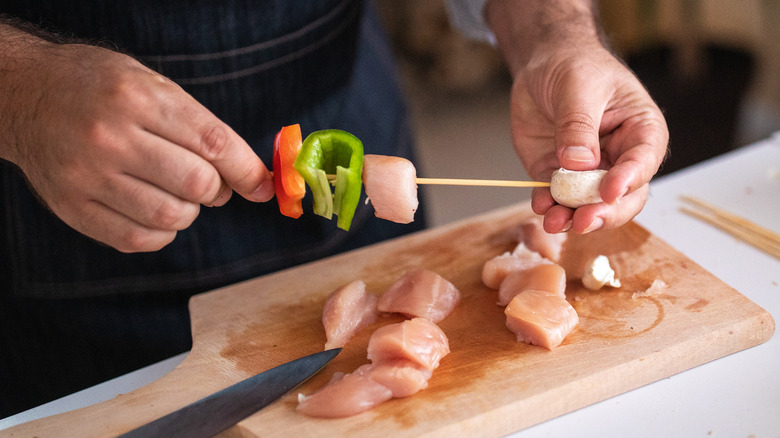The Kebab Assembly Tip For Extra Juicy Results
Kebabs are great on so many levels. Perfect for customizing to your taste, they're an incredibly aesthetic dish to serve at any backyard barbecue. They're also super simple to prepare — that is, with the right know-how. If, however, you have a history of overcooking or burning skewers, we've got the solution. To keep kebabs at their juiciest, you might be curious to learn that proper assembly is everything.
Overcooking can first be avoided by choosing the right protein. In comparison to leaner meats, marbled cuts like chunks of ribeye, flavorful chicken thighs, fatty pork belly, or tender lamb shoulder will produce juicier results because the latent fat melts onto the muscle fibers. Taking the time to prep meat by brining or marinating pieces can also prevent kebabs from becoming dry and rubbery. But no matter what you're working with, proper assembly is by far the surest bet to a juicy skewer.
Building the ideal shish kebab is all about balance. Although you should maximize skewer space, avoid leaving wide gaps between kebab components; ingredients shouldn't be packed on top of one another, as this will lead to uneven cooking. Instead, it's best to thread pieces of fatty meat and pieces of juicy vegetables close enough to touch so that each ingredient's juices will work to keep the other moist during cooking. However, that's not the only trick we've got up our sleeve...
For more succulent kebabs, do this
Despite the fact that mixing proteins and vegetables is a great way to add visual and gastronomic variety to skewers, there is a slight problem in doing so — different ingredients cook at different rates. So, to avoid serving raw or overcooked kebabs, it's best to group ingredients with similar sizes and densities together. For example, thinly sliced beef will cook at roughly the same speed as a single onion layer or piece of pepper, whereas a thicker cube of pork will instead fare better when paired with an equally thick onion wedge or chunk of pineapple.
Once skewers are assembled to proportional perfection, the next part of the equation is ensuring that they stay nice and juicy during cooking. When grilling, it's best to cook kebabs partially over indirect and partially direct heat to prevent the meat from losing too much moisture. As for determining when skewers are done, don't rely on your senses. Save yourself the stress and confusion and reach for a meat thermometer.
Last but not least, after pulling kebabs off of the grill, always let them rest for a few minutes. Rather than dig in right away, giving the meat the chance to rest allows juices to redistribute, guaranteeing the most succulent bite. But why take our word for it? Give these tips a try the next time you whip up shish kebabs!

